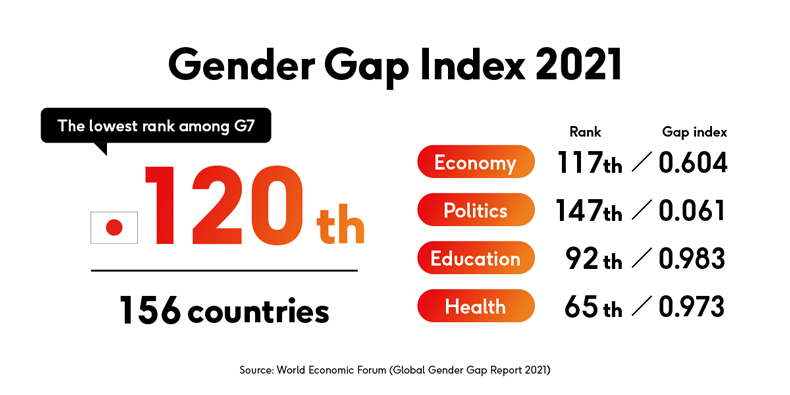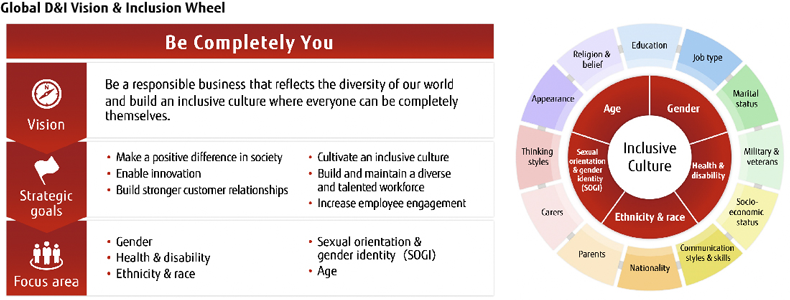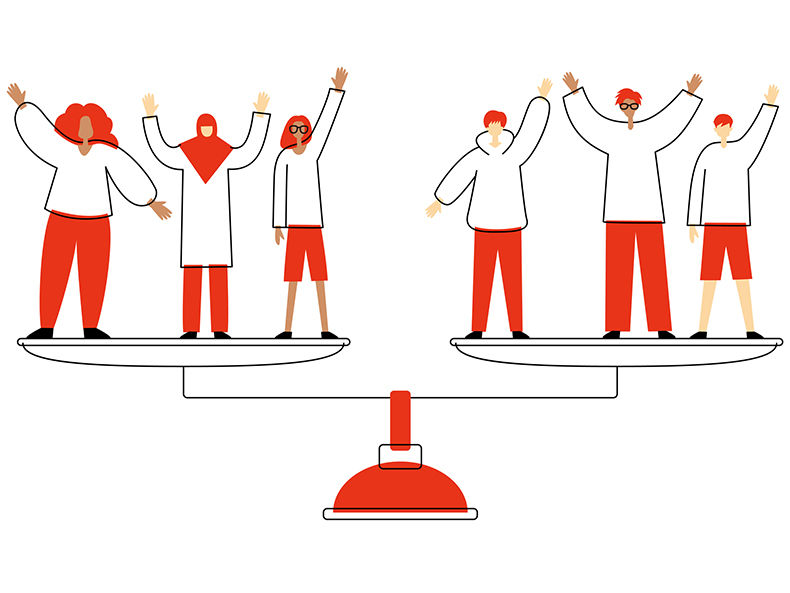- Table of Contents
The Theme of International Women's Day in 2022
International Women's Day is celebrated on March 8 every year. International Women's Day has a long history with its roots in the demonstrations demanding women's suffrage in New York in 1908. In 1975, the United Nations established International Women's Day. The organization sets themes for the day related to gender equality and the empowerment of women that are relevant to that time.
The theme for 2022 is "Gender equality today for a sustainable tomorrow". The UN Women organization has stated that if gender equality does not exist in the present, a future with sustainability and equality for women will be out of reach for all of us.
In Japan, there are calls for gender equality and The Act on the Promotion of Women's Participation and Advancement in the Workplace has been established. However, on the other hand, Japan is ranked 120th out of 156 countries in the Global Gender Gap Index. It is no exaggeration to say that Japan is the lowest ranked among developed countries.
What does this mean exactly? Taking International Women's Day as an opportunity, let's explore the current situation regarding gender equality in Japan, its background, and the path to resolution.
Why is Japan ranked 120th out of 156 Countries?

- Source: Global Gender Gap Report 2021
It's surprising that Japan is ranked in the 120th place in the Global Gender Gap Index. Some people might not believe that it's the lowest ranked among developed countries, and may wonder what on earth the criteria is that causes this undervaluation.
The Global Gender Gap Index is a study conducted by the World Economic Forum since 2006 that measures and quantifies the gender gap across four main areas (subindexes): economy, politics, education, and health.
In the Global Gender Gap Report 2021, published in March 2021, Japan received its lowest ever ranking, coming in at 120th out of 156 countries.
Let's look at the scores for Japan (*1) in each area.
First of all, Japan's ranking in the areas of education and health are 92nd and 65th respectively. Japan's score in education is 0.983. Meanwhile, there are 37 countries with a score of 1.0 (the highest possible score). So, the difference is extremely slim. It's only in the area of higher education that the ratio of male to female students in Japan is slightly lower than in other countries. As for health, the top country scores 0.98, while Japan scores 0.973, so Japan is almost the same as the best performing country.
The gap is not as large as it may look from the country rankings.
There are two more things to look at.
In the area of politics, the result is very serious with Japan coming in at 147th place out of 156 countries, one of the lowest among the countries surveyed. The main reason for this low score is that the number of female parliamentarians and ministers in Japan is extremely low compared to other countries. In terms of the ratio of female members of its House of Representatives (*2), Japan's figure is 9.7%. Out of 190 countries, Japan is ranked 168th. Meanwhile, the figures for the US and France are 27.3% and 39.5% respectively. You can see that these figures are quite low also.
The last area is economy. Japan is ranked 117th, coming in toward the bottom of the rankings. The ratio of job participation in Japan is not much different to that of other countries. However, women's share in senior roles is much lower than other countries with Japan ranked 139th in this respect. So, while the rate of female employees is not low, there are very few women in senior roles. Among the 19 chairs and vice chairs of Keidanren, the Japan Business Federation, there is only one woman. Also, about one-third of publicly listed companies have no female executives.
After looking at each subindex, it is not surprising that Japan ranks low on the Global Gender Gap Index.
Kathy Matsui, former vice chair of Goldman Sachs Japan, estimates that if the gender gap were completely corrected, Japan's GDP would rise by approximately 13%. The negative impact of Japan's gender gap on the economy should not be ignored.
- *1Source: Global Gender Gap Report 2021
- *2
Why Is the Position of Women in Japanese Society Not Improving?

In Japan, policies promoting women's initiatives have been adopted, but progress has been slow.
More precisely, while progress toward gender equality in Japan is being made (Japan's Global Gender Gap Index score was 0.545 in 2006 and it had risen slightly higher to 0.604 in 2021), other countries are moving ahead more quickly.
It is often pointed out that the values in Japanese society have not advanced much. Actually, there are fewer people who support the values from Japan's high-growth period, when men worked outside the home and women worked in the home, than before. However, the older a person gets, the harder it may become for them to change their values. As there are still many male managers who are unable to overcome the old values, men tend to be the ones who get promoted even if there are no differences in ability and performance. This phenomenon is known as the "glass ceiling".
Although the term "work-life balance" has been in place for a long time, it cannot be overlooked that Japanese men still spend a very small amount of time on household work and child-raising compared to other OECD countries, which places a heavy burden on women.
If this burden becomes too great, it may force women to leave the workplace for an extended period of time or in the middle of their careers. It is true for both men and women that if someone leaves and then later returns to work, they will be severely disadvantaged in terms of salary and promotion. This is because of the custom of the lifetime employment system, in which those who have worked for the same company for many years have the most advantageous career paths. In fact, most of the presidents of publicly listed companies with more than 10,000 employees are promoted internally after more than 30 years of service.
However, a report by the Ministry of Health, Labor and Welfare shows that the shorter the number of hours worked, the greater the labor productivity (*1). Companies that are more proactive in achieving work-life balance tend to have higher sales and lower turnover rates. That shows that the era of long work hours has already ended.
We should not view the advancement of women in a male-dominated society as something superficial. We now live in an era of equality and we cannot afford to miss the boat on this opportunity.According to the results of a report from the Government's Bureau of Gender Equality (*2), companies with women in active roles have a higher profit margin, and companies with a higher proportion of women as executives have a higher stock price performance.
- *1
- *2
Fujitsu's Initiatives to Improve the Position of Women

In Japan, many companies are promoting women's initiatives. Finally, we will introduce Fujitsu's initiatives in this respect.
Fujitsu has developed The Global D&I (Diversity and Inclusion) Vision & Inclusion Wheel as a guideline for accelerating efforts toward "inclusion" that goes beyond the realization of diversity in terms of superficial attributes such as gender, disability, and race, and makes the most of individual diversity. Our goal is for all of our employees to "be completely you" and we have defined gender diversity as one of the priority areas for realizing this goal, which is being addressed throughout the Fujitsu Group.

In addition, we have positioned D&I as one of the non-financial indicators in our Global Responsible Business (GRB) goals in our management policy, and we have set the improvement of the ratio of female managers as one of the KPIs related to D&I.
Specific initiatives include a system that allows both men and women to balance work and childcare to support career paths that are divided by childbirth or childcare. In addition, an in-office daycare center has also been established to enable a smooth and quick return to the workplace.
Furthermore, as a career support program, we are conducting career workshops for female employees. In fiscal 2020, Fujitsu introduced a new personnel system, the Posting System, and changed the appointment of management from a conventional recommendation system to one in which employees autonomously consider the career plan they wish to realize and aim for the management position of their own choosing. In line with this system change, we are holding a career workshop for female employees who aim to take management roles in order to assist them in learning about the benefits of holding a managerial position and provide a sense of career ownership.
These measures have steadily increased the ratio of female executives from 5.7% in 2017 to 7.4% in 2020.
In addition, a career event Career Women Festa was held to provide women working not only at Fujitsu but also at other companies as well an opportunity to think about their own career development. Fujitsu executives and employees with a diverse range of experiences spoke about the realities of women working in the IT industry and introduced tips on how to work while being themselves.
In recognition of these efforts to promote the success of its female employees, the City of Osaka awarded Fujitsu the First Prize in the Large Enterprise category (fiscal 2021) as an Osaka City Leading Company in Women's Participation, which are companies recognized as actively working to create a workplace environment that is comfortable for women.
Gender equality is the fifth of the 17 SDGs.At this stage, we still need to be aware of gender equality and change our values not only in companies but also in society as a whole. Ultimately, the goal is a society where we no longer have to actively advocate for the promotion of women's initiatives.
We hope that people will be evaluated based on their abilities, achievements, and qualities as a matter of course, resulting in gender equality, or rather, a society where everyone can "be completely you" with more diversity, not just in terms of gender, which will lead to higher productivity and a more sustainable society.




